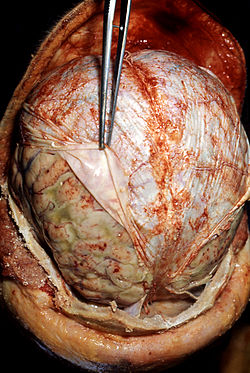Streptococcus pneumoniae
Streptococcus pneumoniae is a gram-positive, facultatively anaerobic, α-hemolytic, viridating coccus that grows in pairs and has a lancet shape. It commonly colonizes the mucosa of the upper respiratory tract in unencapsulated form (70% of children are colonized). It is a conditioned pathogen - in encapsulated form (the case surrounds the whole pair) it can cause serious infections - meningitis, pneumonia, sepsis.
It is usually preceded by other infections and influences that reduce local immunity - elderly patients, with reduced spleen capacity, reduced opsonization, damaged liver. It does not have a group-specific antigen (β-hemolytic only). It is highly sensitive to external influences (important for transport and investigation methods). It is capnophilic and causes β-hemolysis under anaerobic conditions (due to Streptolysin O). Lacks group specific capsule Ag - Lancfield classification. Ag specificity is given by a specific teichoic acid (sometimes also C-substance) that reacts with CRP.
Diagnostic procedure[edit | edit source]
- material: urine, cerebrospinal fluid, sputum
- identification:
- microscopy: G + cocci, staining on cases;
- cultivation: KA (small, transparent colonies with α-hemolysis);
- tests: positive optoquine test, positive bile solubility test.
- serological methods: detection of capsular antigen by immunoelectrophoresis, imunofluorescence.
Virulence factors[edit | edit source]
- capsular polysaccharide antigen (in M and S-phase);
- more variants (80–100), some ex. identical to the blood antigen;
- anti-phagocytic properties, not toxic;
- sheath is a major pathogenicity factor;
- phagocytosis only after complement opsonization (IgG2 anti-encapsulation antibodies) → vaccination;
- pneumolysin,
- cytolysin, retards oxidative processes and chemotaxis PMN;
- necrotizing effects - damage to endothelial and DC epithelial membranes;
- promotes inflammation, needs complement;
- high metabolic activity;
- adhesins, invasins (hyaluronidase, neuraminidase).
Diseases[edit | edit source]
S. pneumoniae is a conditioned pathogen, its infections are preceded by other infections and influences that reduce local immunity (viral infection, aspiration of contaminated nasopharyngeal secretions). He is primarily responsible for the damage inflammatory reaction of the organism – pneumococcus is not toxic but invasive.
Infections caused by S. pneumoniae are:
- pneumococcal pneumonia,
- 20% pneumonia, community-acquired pneumonia
- penetration into the interpleural cavity - purulent deposits, bacteremia (almost always)
- purulent meningitis,
- upper respiratory tract infections: sinusitis, otitis media.
S. pneumoniae It multiplies in the bloodstream, where it consumes blood sugar, especially glucose, which it converts into lactic acid, which can cause a drop in blood sugar and acidosis.
Therapy[edit | edit source]
penicilin is used, however, a number of strains have developed resistance (by modifying the penicillin binding protein, or by using mosaic genes for "pbp" resistance - by recombination of the original DNA with DNA from related species (viridizing streptococci)). The source of resistance is the natural microflora. In addition to penicillin, it is also usedcefalosporin. Alternatives are: macrolides.
- Vaccine: In vulnerable people (immunosuppression, old age, asplenie) vaccination with polysaccharide capsules of 23 types of pneumococci is performed.
Photo gallery[edit | edit source]
- Streptococcus pneumoniae M-phase-blood agar-detail hemolyzy.jpg
Cultivation of Streptococcus pneumoniae on blood agar, M-phase, detail of hemolysis
Summary video[edit | edit source]
https://www.youtube.com/watch?v=VcU_xgSzk4k
Links[edit | edit source]
[edit | edit source]
- Streptococcal infections: Group A streptococcal infection • Scarlet fever • Sleep angina • Erysipel • Impetigo • Infections caused by virulent streptococci • Complications and treatment of streptococcal infections • Rheumatic fever
References[edit | edit source]
- BEDNÁŘ, Marek, Andrej SOUČEK and Věra FRAŇKOVÁ, et al. Medical microbiology: Bacteriology, virology, parasitology. 1st edition. Prague: Marvil, 1996. 558 pp. ISBN 8023802976 .
- RYŠKOVÁ, Olga, et al. Microbiology for dentistry students. 1st edition. In Prague: Karolinum, 2004. ISBN 80-246-0834-0 .
- ŠMÍROVÁ, Václava. Introduction to medical microbiology. - edition. -.
- JANSKÝ, Petr. Processed questions from microbiology [online]. [feeling. 2012-04-21]. < https://www.yammer.com/wikiskripta.eu/uploaded_files/3804405 >.





